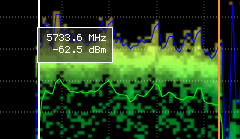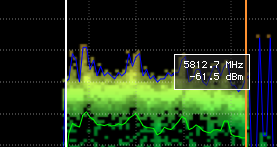802.11ac RF Hands-On with Buffalo AirStation WZR-1750H
by Brian Klug on January 11, 2012 5:06 PM ESTWe just stopped by Buffalo's booth at CES 2012, who were kind enough to let us use a WiSpy DBx from Metageek we're working on reviewing to look at an 802.11ac signal. The WiSpy DBx is an inexpensive (for spectrum analyzers) spectral analysis tool, and with 802.11ac specifically the interesting thing to look at is what 80 MHz OFDM window. This is as opposed to the 20 or 40 MHz channels that are a part of 802.11n.


With the markers shown, clearly 80 MHz OFDM
Buffalo was running a 3x3:3 80 MHz 802.11ac demo at their booth, with two AirStation WZR-1750H APs and their visible Broadcom miniPCIe 802.11ac solution visible. The two cards were just wired together (even though 802.11ac works on 5 GHz) just to ensure no spectrum crowding issues affected the demo. However, Buffalo let us get nice and close to the pigtails, close enough to catch some of the 5 GHz RF leaking out. Wired together the simple network with two APs talking to each other was doing just over 800 Mbps of traffic.
















16 Comments
View All Comments
jwilliams4200 - Saturday, January 14, 2012 - link
You do know what a Faraday cage is? If not, you should probably look it up on wikipedia.A better question is, why do you make claims that you cannot prove? You said "NONE" of the wireless equipment would work at CES -- you were quite emphatic about the "NONE". That claim can only be proved if you have tested every piece of wireless equipment and found that none of them work. Obviously you are just making it up.
Given that cell phones can work in such an environment, it is not a big stretch to realize that a well-designed piece of wifi equipment could also work.
I feel sorry for your customers.
LTG - Wednesday, January 11, 2012 - link
That WiSpy DBx thingy is pretty cool.Could that kind of software be created using only the wifi already built into a laptop or tablet?
I'm not sure what their hardware itself offers other than a larger antenna...
DanNeely - Wednesday, January 11, 2012 - link
My first guess would be no. To keep costs down I assume throwing away high fidelity samples of the RF data everywhere outside the wifi units selected channels frequency. This would make looking at the entire 24/5ghz band rather difficult.MarkYensen - Thursday, January 12, 2012 - link
Mark at MetaGeek here.Chanalyzer software requires data taken from hardware that is not found in most laptops or tablets, namely a narrowband transceiver. This is why the Wi-Spy hardware is necessary to collect raw spectrum data.
If you're interested heck out this post on how Wi-Spy works: http://www.metageek.net/blog/2011/01/how-wi-spy-wo...
Ryan Smith - Wednesday, January 11, 2012 - link
You must be having a field day Brian. There's so much wireless interference at CES that your WiSpy should be lighting up like a Christmas tree.Though kudos to Buffalo for letting you use it on their 802.11ac gear. And I'm glad to see Buffalo realizes that CES is not the time to rely on WiFi for your product demos.
Brian Klug - Thursday, January 12, 2012 - link
I seriously *am* having a field day :P-Brian